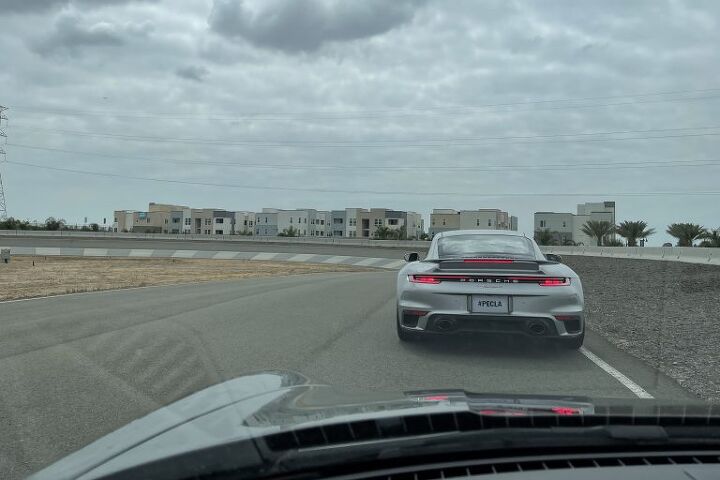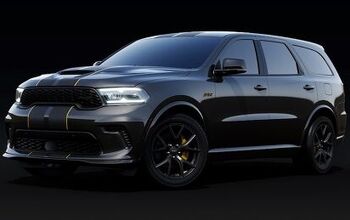Piloting Stuttgart's Latest And Greatest At The Porsche Experience Center
While Audi, Mercedes-AMG, and other luxury automakers hold performance driving programs at various race tracks across the U.S. and abroad, years ago Porsche decided to take a different tack. Now operating in seven different locations around the world, its Porsche Experience Centers are basically automotive playgrounds that showcase the brand’s performance heritage and contemporary racing efforts while also providing a facility for customers to build out custom specifications in the Personal Design Studio. The most interesting feature of the PECs, though, is the Driver Development Tracks. These purpose-built proving grounds allow drivers to put the capabilities of Porsche’s various vehicles to the test – whether that’s the at-limit handling of a Cayman or the off-road prowess of a Cayenne.
The Los Angeles location is Porsche’s newest PEC U.S. facility, offering 53 acres of various “modules” that are designed to put PEC’s fleet (which encompasses Porsche’s entire production lineup) through their paces. Would-be participants can choose from a variety of different programs that range from car control basics to advanced, multi-day Academy schools that focus on racing techniques.
When Porsche offered me a chance to run a 2021 911 Turbo S through the gamut at PEC and then subject a 2021 Taycan Turbo S to the same series of tests, it struck me as a rare opportunity to not only get an objective comparison between traditional ICE sports car performance and its EV counterpart in the same context, but also a better understanding of how the performance philosophies differ within the same brand. And it also, you know, sounded like a hell of a lot of fun.
Speed The Conventional Way
Upon my arrival at PEC, I was greeted by Hunter Feldman, a Porsche driving coach and my automotive Sherpa for the day, who explained that we’d be starting off with the 911.
Motivated by a 640-horsepower, twin-turbocharged 3.7-liter flat-six that catapults it from a standstill to 60 mph in just over 2 seconds on the way to a low 10-second quarter-mile, the all-wheel-drive Turbo S currently sits at the top of the 992-generation 911 range. But before we’d put its quickness to the test, Feldman directed me to wheel the 911 over to the Low Friction Circle module.
Essentially a skidpad with a polished concrete surface, it’s constantly sprayed with recycled water from built-in sprinklers in order to make it easy to break traction so drivers can work on their car-control skills. Feldman instructed me to click the drive mode knob on the steering wheel over to Sport Plus but to leave PSM (Porsche’s version of traction and stability control) on. The combination ensures that the engine and eight-speed dual-clutch gearbox are responsive to inputs while also leaving the electronic nannies on high alert.
The result is understeer on demand, of course. Feldman wants to make sure I know what to do when the front end wants to push wide, and simply easing off the throttle is enough to bring the 911 back in line. Soon after, he buzzed me on the radio and told me to hold down the PSM button for 5 seconds. A short press will put Porsche Stability Management in Sport mode, where it’s still partially active, but a long press turns PSM off.
With PSM off, it was up to me to make the 911 dance. Feldman noted that since the 911 Turbo S is all-wheel drive, it behaves differently than a rear-wheel-drive car when coaxed into oversteer, and your inputs need to change, too. To illustrate this, he headed out onto the skidpad in a 911 Turbo S of his own and pitched it into a drift. After counter-steering his way around the skidpad for a rotation or two, he carefully brought the car completely sideways, straightened the front wheels out, and used nothing but throttle and brake inputs to keep the car sliding around the pad.
My attempts were not as elegant. A quick stab of the throttle was enough to get the back end to kick out, but maintaining that power slide was an entirely different matter. With 640 horsepower at your right foot’s command, it’s incredibly easy to overdo it, and the AWD system requires some mental recalibration when comes to your inputs. The bigger takeaway, though, is that drifting is not about reacting – it’s about planning ahead.
After finishing up at the Low Friction Circle, we headed over to the aptly named Acceleration Straight. It’s more than just a mile-long stretch of tarmac, though; at the end of it there’s a high-grip, 33-percent banked loop which was designed to replicate the Carousel at the famed Nurburgring road course in Germany. Minus the graffiti, of course.
There were two starting lines – one for Feldman, and one for me about 100 yards behind. Over the radio, he walked me through engaging the 911’s launch control. Unlike some manufacturers, Porsche has made the process incredibly straightforward: Put the car in Sport or Sport Plus mode, press the brake pedal down, and with the brake still held, press and hold down the throttle.
Once the engine spooled up, Feldman counted down from three. On “GO” I side-stepped the brake pedal and the 911 leapt off the line without a hint of turbo lag. We reached nearly 140 mph before scrubbing off speed for the Carousel, where 60 mph seemed to be the sweet spot to keep the car firmly pinned to the tarmac. It’s the kind of exercise that begs you to brake later and carry more speed into the sweeper with each repetition, but it wasn’t long before Feldman indicated that it was time to head over to the main attraction.
PEC’s Handling Circuit is a tight, technical 1.3-mile track with a solid variety of different corner types and elevation changes. The 911 Turbo S’s biggest strength may be its straight-line oomph, but it still feels right at home on a road course. Thanks to a relatively small footprint and excellent outward visibility it’s easy to place the car right where you want it when setting up for a turn, and the front end provides plenty of warning as you approach the limits of grip. There’s a brutal amount of power on tap, but all-wheel drive makes it manageable, and the gearbox logic is also so dialed in that I didn’t even bother messing with the steering-wheel-mounted paddle shifters.
Feldman kept us in a lead-follow format, and along the way he kept tabs on my technique, calling out sections where I could brake later, turn in sooner, or clean up my line to get more out of the car. Despite the sheer breadth of performance capability it offers, the 911 Turbo S felt approachable even in its most aggressive drive modes, and it never did anything that caught me by surprise. Even if the 911 is considered the “old guard” technologically, there’s a reason why it remains a sports car benchmark.
Electrifying The Grid
After our stint on the road course with the 911 concluded, we headed back to the pits to have a go in the Taycan Turbo S. Don’t let the number of doors fool you – this thing can dance. Out on the Low Friction Circle the additional weight of the 5,100-pound EV is evident, particularly during the understeer exercises, but so is the power. With all of the electronic assistance turned off the 750 hp Taycan Turbo S will partake in sideway antics just like 911 does, but keeping it on the intended line requires an even more precise interplay between steering and throttle inputs when there’s 774 pound-feet of torque always at the ready.
Given that, it probably doesn’t come as a surprise that the Acceleration Straight really puts the Taycan’s biggest strength on display. Launch Control is called up in exactly the same manner as it is in the 911, and even though I braced for the thrust that would ensue, it still slammed my skull into the headrest the first time I pinned the go pedal. It’s a few tenths behind the 911 in the sprint to 60 mph (and on the top end – we were on the brakes for the Carousel just before hitting 130 mph), but the initial 0-30 mph dash actually feels more urgent. Importantly, the Taycan is also willing to do launch control starts repeatedly and without additional preparation, and the same can’t be said for some other high-performance EVs.
While it’s not as eager to change direction as the 911 out on the road course, the low center of gravity provided by the battery pack makes the Taycan more nimble and rewarding to throw around than you might expect it to be. The air suspension does a remarkable job of corralling body motions to provide flat cornering while remaining compliant enough to absorb mid-corner bumps without any drama, and the beefy front brakes (which feature massive 10-piston calipers) are definitively up to the task. It all equates to a car that’s genuinely entertaining to drive hard, and not just in a straight line.
As I pulled the EV back into the staging area after my program concluded, I took note of the 911 GT3s and 718 Cayman GT4s that sat there patiently waiting for their next thrashing. It’s hard to ignore the feeling that their days are numbered, and the anxiety it triggers in me makes me wonder if I’m part of the old guard, too. It’s going to take more than instant torque to get me to forget about the extra 1,500 pounds – or the sound of a flat-six at wide-open throttle, for that matter. Still, if the Taycan Turbo S is a harbinger of what lies ahead, maybe the future won’t be so bad after all.
[Images © 2021 Bradley Iger/TTAC, Porsche]
More by Bradley Iger
Latest Car Reviews
Read moreLatest Product Reviews
Read moreRecent Comments
- ToolGuy Toyota is confused.
- 28-Cars-Later Just one of many problems.
- ToolGuy Here's some info on the "MEB" -- including this quote:"The Modular Electric Toolkit jettisons all the ballast of the fossil age"And Ford is teaming up with these guys? I see nothing but good things coming from this collaboration. 😉 Very clear direction, everyone on the same page.(Pretend that I'm sitting in a renovated train station while I'm saying this, and it will have more gravity.)
- Rick T. "The top-down push to electrification is even more puzzling here, as the U.S. has a notoriously sparse charging network, and EVs remain too expensive for a large portion of buyers."I'm not sure what top down pushes of any kind have had to do with reality on the ground.
- Ajla But no ES500h at this time? 🤔 I'd be a little surprised if they bothered to make a trim with the 2.4T or any other ICE-only version. I'm thinking a 250hp AWD hybrid will be the "ES350h". Then whatever these "e" versions are and then maybe something with the Hybridmax.









































Comments
Join the conversation
Lets not forget Henry Ford was a nazi sympathizer.
Lemme see, TTAC used to have an editor who both owned and raced Porsches. He wrote about Porsche racing and Porsche owner ship. This is a write-up about a day of fellatio from a corporate PR flak. I doubt that Taycan will be driven over something as demanding as Jeep's auto-show display/course.